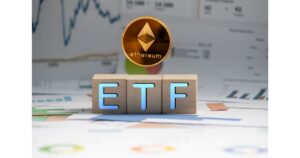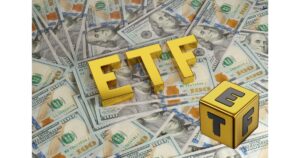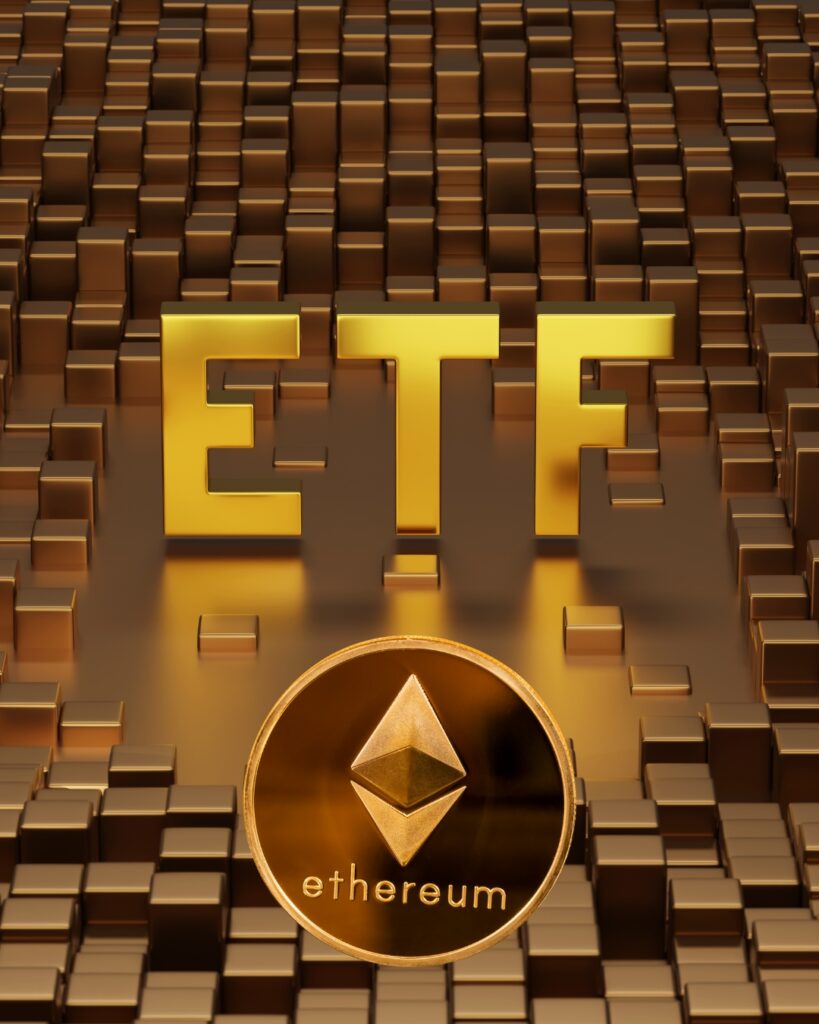It may take until October for traders to witness an Ether ETF rally above $3,000. This is predicted by certain analysts.
For the initial time in more than two weeks, inflows into Ether ETFs (exchange-traded funds) have started to increase.
For the first time since August 14, the nine United States spot Ether ETF $2,525 exchange-traded funds had net positive inflows totaling $5.9 million.
Data from Farside Investors shows that the biggest daily inflow was $8.4 million into BlackRock’s ETF (ETHA).
Grayscale’s Ether ETF (ETHE), which witnessed the lowest daily outflow in more than two weeks, $3.8 million, helped to slow outflows and turn negative inflows.
But since the ETFs began trading on July 23, Grayscale has liquidated more than $2.5 billion worth of Ether, raising the possibility of further selling pressure.
Since ETH ETF arrival, ether value has dropped by 25%
The price of ETH has been declining despite high expectations for the historic launch of the United States Ether ETFs.
Since the launch of the ETH ETFs more than a month ago, the price of ether has decreased by more than 25%. As of 2:14 pm UTC, it was $3,441 on July 23.
Zooming out, the price of ether has increased by more than 56% in the last year and by around 13% year-to-date (YTD).
When Bitcoin (BTC) crossed the $50,000 threshold on February 15, spot ETFs made up around 75% of all new investments in the cryptocurrency.
Ether caught between a critical $2.7K resistance
The lead analyst for research at Nansen onchain analytics platform, Aurelie Barthere, claims that the price of ether is still stuck below the crucial $2,700 resistance line.
The upcoming level of resistance for Ether is 2.7k, and there isn’t enough data to say that it has been breached yet, the expert told Cointelegraph. because there was insufficient volume and duration of price resistance above this level.
According to Coinglass statistics, a potential rise above $2,700 would eliminate leveraged short bets totaling over $362 million across all cryptocurrency exchanges.
A possible Ether break above $3,000 is being watched by traders as the market bounces back from the summer’s lack of liquidity in October.
Within a week, Ethereum DApp traffic increased by 36%. Will the price of ETH follow?
Ethereum DApp interactions are increasing, yet the price of ETH has not changed.

Although Ether ETF has increased by 7.5% from its August 27 low of $2,396 to $2,525 today, the 22% fall in the last 30 days suggests that investors are still apprehensive about their stakes. The price of Ether has not yet indicated that it will return to the $3,800 levels observed in early June, despite the fact that network activity on Ethereum is growing.
Partially explaining ETH depreciation is the lackluster demand for spot Ether ETFs
Given that Ether has disappointed its peers and that the market value of altcoins has dropped by 13% in the last 30 days, the scenario is even more worrying. The excessive anticipation surrounding the planned July 24 debut of a spot exchange-traded fund (ETF) in the United States is partially to blame for this shift. But there’s more to the story—as of April 24, Ether was trading at $3,200.
The recent decline in Ethereum’s average transaction cost, which dropped under $1 for the initial time in four years, is what ether bulls are banking on. When combined with the effective use of layer-2 solutions for larger throughput projects, Ethereum continues to dominate decentralized apps (DApps).
Ether bears contend that rival networks give new users an easier time since they have lower base layer fees. The larger centralization of Tron TRX $0.1572 or BNB Chain BNB $537, as well as the exorbitant expenditures associated with operating a Solana SOL $138 validator, actually don’t worry most users. The popularity of Base, Ethereum’s own layer-2 solution, suggests that customers place a higher importance on direct Coinbase access than they do on sovereignty.
Total Value Locked and volumes on the network of Ethereum are growing
No matter if Ether’s layer-2 ecosystem contributes to its price, the overall amount locked (TVL) on the network of Ethereum has been increasing. DefiLlama reports that the total money deposited in Ethereum DApps rose to 18.9 million ETH, a 4% increase over the previous two weeks. On the other hand, deposits on Avalanche decreased by 4% within the same period, but Tron’s TVL decreased by 10% in TRX terms.
The most notable TVL increase over the previous two weeks was seen by Symbiotic, a recently established holding project on the network of Ethereum, which increased 83% to 640,310 ETH. Similarly, there was a 15% increase in total deposits on Ether.fi’s liquid staking technology. To say, however, that Ethereum’s network activity has increased just because its TVL has been analyzed would be inaccurate, since most DApps don’t need substantial deposit bases.
According to DappRadar, among July 22 and July 29, Ethereum’s DApp volumes climbed by 36% as a result of network activity. The decentralized trading platform Uniswap saw a 35% increase in volume to $30.8 billion, while the computerized market maker Balancer saw a 46% increase in volume to $18.1 billion. Conversely, DApp volumes on the SOL network have remained relatively stable at approximately $6.3 billion every week.
The quantity of current address and transactions is decreasing
Nevertheless, since August 22, not all facets of Ethereum’s network activity were favorable. For instance, while the entire amount of transactions decreased by 8%, the amount of active addresses communicating with DApps remained constant. On the other hand, Solana added 10% more users in the same time frame, and BNB Chain witnessed a 7% rise in active addresses.
According to statistics from Farside Investors, spot Ether ETF funds have suffered total outflows of $107 million during the last two weeks, which is another factor impeding Ether’s performance. Considering the bullish momentum for comparable Bitcoin BTC $59,228 spot ETF devices, which saw $523 million in total inflows over the same time, this data demonstrates a shortage of interest from large-scale investors.
In the end, there aren’t any obvious indications of enthusiasm in the network of Ethereum that would support a notable rise in Ether’s cost. Given that rivals like BNB Chain and Solana provide significantly lower fees, some may contend that Ethereum’s average transaction fee decrease to less than $1 is still insufficient. Ultimately, the evidence points to a lack of a direct correlation between onchain activity and Ether’s price.
Expectedly, the $3K price of Ethereum surge will occur in October
In order to position itself for a breakthrough over $3,000 in Q4 2024, the price of ether still needs to clear the crucial $2,700 resistance.
Analysts in the market predict that Ether might rise to $3,000, although that might not happen until the end of 2024. How soon will Ether be able to get past the crucial $2,700 barrier?
Ether is expected to break above $3,000 in Q4 of this year
Crypto expert Poseidon stated in an Aug. 28 X post that the Ether ETF $2,527 price looks to be positioning itself for a price surge over the $3,000 psychological mark:
I stuck to the plan and my long positions filled below $2500. The price analyzed the daily demand, cleared equal lows, and then rose above it once more. It’s still too early to discuss, but all signs point to sending it above $3,000.
There will be a breakout, according to several analysts. However, market expert Elja Boom speculates that the price surge for ether might not happen till the fourth quarter of 2024.
In an X post dated August 28, the analyst stated: “ETH continues to trade over EMA 50 support level.” Capitulation on prices has occurred. Right now, the dull part is still ongoing as the price stays within a predetermined range. As I still believe there won’t be a breakout before Q4.
A technical indicator that tracks the average cost of an inventory over the previous 50 days is the 50-day exponentially moving average (EMA), which is frequently used to identify local support.
Ether whales amassed 200,000 Ether worth approximately $540 million in 4 days preceding August 26, according to famous analyst Satoshi Sniper, which is another positive indication, as said in an X article.
Can the price of ETH overcome the crucial $2,700 resistance?
It will be difficult to break the strong resistance that ether retains around $2,700, according to Aurelie Barthere, chief analyst for research at Nansen onchain analytics platform.
Based on CoinGlass data, a potential rebound in ether above $2,700 would eliminate leveraged short bets totaling approximately $481 million across all exchanges.
Conversely, bearish on ether contend that a decline to $1,750 is conceivable, citing the pseudonymous trader Mizuhara’s Aug. 28 X post, which said, “Either dead cat rebound here or $1,750 next.” Quick and simple.
A dead cat rebound is the term used by traders to describe an asset’s brief price recovery following a large correction, which is then followed by further decline.
Ethereum whales purchase heavily as the ETH bottom draws near, analysts says
Although net withdrawals from Ether ETFs are expected to total $500 million, market observers believe that the ETH bottom may have been reached.
Over the last four days, ether whales have amassed over 200,000 Ether ETF $2,525—a value of over $540 million—according to statistics released by prominent analyst Satoshi Sniper in an Aug. 26 X post on CryptoQuant.
The whale purchases occur in spite of Ether’s weak price movement, which seen the token drop more than 4% in the day before it traded at $2,627 at 12:37 p.m. UTC on August 27.
Even if Ether ETF outflows are almost $500 million, whales continue to accumulate
Despite the spot Ether ETF exchange-traded funds slow progress in the US, cryptocurrency whales are nonetheless piling up Ether.

According to statistics from Farside Investors, the nine United States spot Ether ETFs have had cumulative net outflows of $478 million since their introduction.
Most of those withdrawals were from the Grayscale Ethereum Trust ETF, which has shed $2.5 billion in Ether since the ETFs’ July 23 launch.
When Bitcoin (BTC) crossed the $50,000 threshold on February 15, spot ETFs made up around 75% of all new investments in the cryptocurrency.
Research analyst at Fineqia International Matteo Greco said that the aggregate trading volume of Ether ETFs indicates that traditional investors’ appetite is still a ways off.
In an analysis note that was sent to Cointelegraph, the analyst wrote: Even after accounting for market size, the total amount of Ether ETF spot trades last week was $830 million, indicating much less trading activity than BTC. This shows that traditional finance traders have not yet demonstrated persistent interest in financial products linked to Ethereum, despite strong price action for ETH.
Is the bottom in for Ether?
The bottom of the Ether price may be in, notwithstanding the ongoing withdrawals from Ether ETFs.
According to prominent market expert CryptoBullet, as far as Ether stays above $2,500, the bottom will eventually be reached. The low is in, and the unbreakable support cluster lies between $2,500 and $2,100, the analyst stated in an X post dated August 18. I continue to believe that a spectacular rally is imminent, but first we might need to spend a few weeks consolidating near the 0.618 Fibonacci level and MA100.
However, Aurelie Barthere, lead research analyst at Nansen, notes that the $2,700 barrier continues to be a big obstacle for the Ether price. This level will determine price movement with Nvidia’s upcoming earnings announcement scheduled for August 28.
Titan of Crypto, a well-known expert, believes that Ether may be poised for a psychological rise to $3,000. He stated in an X post from August 27 that the price may move as high as $3,000 in the near future due to the difference on the ETH CME Futures 4H chart.
In Brazil, BlackRock introduces the Ether ETF
The asset manager has introduced the newly released iShares Ethereum Trust via a depositary receipt, broadening its selection of cryptocurrency-based products in Brazil.
BlackRock is growing the range of cryptocurrency products it offers abroad. The firm issued its Ether ETF exchange-traded fund on Brazil’s stock exchange B3 on August 28 by use of a depositary receipt.
Retail and institutional investors are reportedly able to make trades on the iShares Ethereum Trust (ETHA) in the nation under the ticker ETHA39.
A security that represents shares in an outside fund or firm is called a depositary receipt. Usually, it is supported by the original asset and exchanged in the local currency. The shares of BlackRock’s Ether ETF $2,525 exchange-traded fund will be made available to the local market at a price equal to 1/3 of their initial value.
In the meantime, management costs will be determined annually at 0.25% to match US rates. But these fees will be cut in half to 0.12% for the initial year of trading, or until the ETF manages $2.5 billion in assets.
Cristiano Castro, the director of BlackRock in Brazil, stated in an informal interview that the investment fund will satisfy the nation’s rising demand for cryptocurrency assets:
During the course of three months, [IBIT] has grown at the quickest rate in ETF history. This indicates that the product was in high demand. In order to satisfy investor demand and facilitate investors’ access to these electronic goods within the capital market, BlackRock has adopted a strategy.
among the initial markets to permit the trade of products related to cryptocurrencies on its stock exchanges was Brazil. The world’s first spot Solana-based exchange-traded fund was approved by local regulators in July, and it is anticipated to launch in the upcoming months.
In the initial 5 months of 2024, the country’s cryptocurrency trading volume hit $6 billion, a 30% rise from the year before.




 Bitcoin
Bitcoin  Ethereum
Ethereum  Tether
Tether  Solana
Solana  USDC
USDC  Lido Staked Ether
Lido Staked Ether  XRP
XRP  Toncoin
Toncoin  Dogecoin
Dogecoin  Cardano
Cardano  TRON
TRON  Shiba Inu
Shiba Inu  Avalanche
Avalanche  Wrapped Bitcoin
Wrapped Bitcoin  Polkadot
Polkadot  Chainlink
Chainlink  Bitcoin Cash
Bitcoin Cash  Uniswap
Uniswap  NEAR Protocol
NEAR Protocol  LEO Token
LEO Token  Dai
Dai  Litecoin
Litecoin  Polygon
Polygon  Wrapped eETH
Wrapped eETH  Internet Computer
Internet Computer  Pepe
Pepe  Ethena USDe
Ethena USDe  Ethereum Classic
Ethereum Classic  Artificial Superintelligence Alliance
Artificial Superintelligence Alliance  Aptos
Aptos  Stellar
Stellar  Monero
Monero  Maker
Maker  Hedera
Hedera  Stacks
Stacks  Cronos
Cronos  Render
Render  Filecoin
Filecoin  Cosmos Hub
Cosmos Hub  OKB
OKB  Mantle
Mantle  Arbitrum
Arbitrum  Renzo Restaked ETH
Renzo Restaked ETH  Immutable
Immutable  Sui
Sui  Injective
Injective  Optimism
Optimism
Usually I do not read article on blogs however I would like to say that this writeup very compelled me to take a look at and do it Your writing style has been amazed me Thank you very nice article
Hi my loved one I wish to say that this post is amazing nice written and include approximately all vital infos Id like to peer more posts like this
Winston here from Iowa. I’m always watching to see what newer sites are going up and I just wanted to see if you would like an extra hand with getting some targeted traffic, Create custom AI bots to answer questions from visitors on your site or walk them through a sales process/funnel – I could even make a persona of yourself or employee to field questions about your business. I create/edit videos/images/adcopy, create/revamp/update sites, remove negative listings, the list goes on. I’ll even shoulder 90% of the costs, dedicating my time and tools that I’ve created myself and bought over the years. I’ve been doing this for over 22 years, helped thousands of people and have loved every minute of it.
There’s virtually no cost on my end to do any of this for you except for my time starting at 99 a month. I don’t mean to impose; I was just curious if I could lend a hand.
Brief history, I’ve been working from home for a couple decades now and I love helping others. I’m married, have three girls and if I can provide for them by helping you and giving back by using the tools and knowledge I’ve built and learned over the years, I can’t think of a better win-win.
It amazes me that no one else is helping others quite like I do and I’d love to show you how I can help out. So, if you need any extra help in any way, please let me know either way as I value your time and don’t want to pester you.
PS – If I didn’t mention something you might need help with just ask, I only mentioned a handful of things to keep this brief 🙂
All the best,
Winston
Cell – 1-319-435-1790
My Site (w/Live Chat) – https://cutt.ly/bec4xzTQ